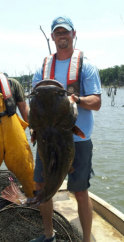
Randy finished his post-doc in 2015 and is now a statistician with the U.S. Fish and Wildlife Service in New Mexico.
Randy is a post doctoral researcher that specializes in applying quantitative tools to better understand processes in ecology and management. His active research focus is developing stock assessment models and evaluating population dynamics, modeling species distributions, decision-making, and trophic-level dynamics. He is currently working on the native fish prioritization project. This consists of developing multi-level, multi-species occupancy models, coupled with prioritization analysis, to identify areas that contain both the native fish fauna and species of greatest conservation need. The resulting model will enable the prioritization of areas for conservation, and to better inform and direct management actions of decision makers. He graduated with his doctoral degree in Natural Resource Ecology and Management from Oklahoma State University in 2013.
Publications
Stewart, D. R., J. M. Long, and D. E. Shoup. In Prep. Modeling the response of minimum and maximum size limits on Ictalurus fisheries throughout the United States.
Brewer, S. K., T. Worthington, R. Mollenhauer, D. R. Stewart, and P. Kemp. In Prep. Synthesizing ecohydrology models as a management tool for landscape conservation under climate change.
Stewart, D. R., and J. M. Long. In Prep. Using SideScan sonar and hierarchical Bayesian multi-species mixture models to estimate habitat associations of reservoir fishes.
Stewart, D. R., A. W. Walters, and F. H. Rahel. In Review. Landscape-scale factors influencing native and nonnative Great Plains fish distributions.
Long, J. M., D. R. Stewart, D. Balsman, J. Shiftlet, and D.E. Shoup. In Review. Bait type influences catch and bycatch in tandem hoop nets set in reservoirs.
Stewart, D. R., and J. M. Long. In Review. Using hierarchical Bayesian multi-species mixture models to estimate tandem hoop-net based habitat associations and detection probabilities of fishes in reservoirs.
Stewart, D. R., and J. M. Long. 2015. Growth and contribution of stocked channel catfish, Ictalurus punctatus (Rafinesque, 1818): the importance of measuring post-stocking performance. Journal of Applied Ichthyology. doi:10.1111/jai.12797.
Stewart, D. R., and J. M. Long. 2015. Using an experimental manipulation to determine the effectiveness of a stock enhancement program. Journal of Freshwater Ecology. doi:10.1080/02705060.2015.1021715.
Stewart, D. R., J. M. Long, and D. E. Shoup. 2015. Spatial structuring within a reservoir fish population: implications for management. Marine and Freshwater Research 66:202-212. http://dx.doi.org/10.1071/MF14085.
Cartabiano, E., D. R. Stewart, and J. M. Long. 2014. Effect of bait and gear type on channel catfish and turtle bycatch catch statistics in a reservoir. Journal of Freshwater Ecology. doi:10.1080/02705060.2014.966165.
Stewart, D. R., G. D. Scholten, T. N. Churchill, and J. M. Fly. 2012. Angler opinions of catfish management in Tennessee. Proceedings of the Southeastern Association of Fish and Wildlife Agencies 66:88-93.
Stewart, D. R., and J. M. Long. 2012. Precision of channel catfish catch estimates in medium size impoundments in Oklahoma. North American Journal of Fisheries Management 32:1108-1112.
Stewart, D. R., and J. M. Long. 2011. The efficacy of mass-marking channel catfish Ictalurus punctatus fingerlings using oxytetracycline. Proceedings of the Oklahoma Academy of Science 91:31-36.
Long, J. M., and D. R. Stewart. 2010. Verification of otolith identify used by fisheries managers for aging channel catfish Ictalurus punctatus. Transactions of the American Fisheries Society 139:1775-1779.
Stewart, D. R., G. W. Benz, and G. D. Scholten. 2009. Weight-length relationships and growth data for blue catfish Ictalurus furcatus among four Tennessee waterbodies. Proceedings of the Southeastern Association of Fish and Wildlife Agences 63:140-146.
Ulicny, K. J., D. R. Stewart, A. McElwain, E. R. Salmon, S. A. Bullard, J. O. Cook, G. D. Skomal, H. L. Pratt, Jr., and G. W. Benz. 2007. Sealing Whirl-Pak®-type bags containing wet samples. Tennessee Academy of Science 88-89.
Book Chapter
Stewart, D. R. 2014. Species account and life history description of channel catfish Ictalurus punctatus. Kansas Fishes. University Press of Kansas 496 pg.
Selected Presentations
Stewart, D. R., J. M. Long, and D. E. Shoup. 2014. Spatial structuring in a reservoir fish population: implications for management. American Fisheries Society Colorado-Wyoming Annual Meeting, Laramie, WY.
Brewer, S. K., T. Worthington, R. Mollenhauer, D. R. Stewart, and P. Kemp. 2014. Synthesizing ecohydrology models as a management tool for landscape conservation under climate change. Oklahoma Clean Lakes and Watershed Conference, Stillwater, OK.
Cartabiano, E., D. R. Stewart, and J. M. Long. 2014. Examination of gear and bait choice to minimize by-catch when sampling for channel catfish in reservoirs. American Fisheries Society Southern Division Annual Meeting, Charleston, SC.
Stewart, D. R., and J. M. Long 2013. Density dependence affects growth of stocked channel catfish as revealed by stable isotope analysis. American Fisheries Society National Annual Meeting, Little Rock, AR.
Stewart, D. R., and J. M. Long. 2013. The use of side-scan sonar as a tool to map habitat in Oklahoma reservoirs. Oklahoma Clean Lakes and Watershed Conference, Stillwater, OK.
Stewart, D. R., and J. M. Long. 2013. Influence of stocking and competing species on the trophic ecology of channel catfish in Oklahoma reservoirs. American Fisheries Society Southern Division Annual Meeting, Nashville, TN.
Stewart, D. R., G. D. Scholten, T. N. Churchill, and J. M. Fly. 2012. Angler opinions of catfish management in Tennessee. Southeastern Association of Fish and Wildlife Agencies Annual Meeting, Hot Springs, AR.
Stewart, D. R., and J. M. Long 2012. Contribution of 178-mm channel catfish in two medium size reservoirs in Oklahoma. American Fisheries Society Southern Division Annual Meeting, Biloxi, MS.
Stewart, D. R., and J. M. Long. 2011. A survey of catfish anglers from six Oklahoma reservoirs. Oklahoma Chapter American Fisheries Society Southern Division Annual Meeting, Wagoner, OK.
Stewart, D. R., and J. M. Long. 2011. Population dynamics of channel catfish from six Oklahoma reservoirs. Oklahoma Chapter American Fisheries Society Annual Meeting, Wagoner, OK.
Stewart, D. R., and J. M. Long. 2010. Verification of otolith origin used for aging channel catfish by fisheries managers. American Fisheries Society National Annual Meeting: Merging Rivers, Pittsburg, PA.
Invited
Stewart, D. R. 2013. Factors related to stocking success of 178-mm channel catfish in Oklahoma reservoirs. Natural Resources Ecology and Management Seminar Series, Oklahoma State University, Stillwater, OK.
Stewart, D. R., and J. M. Long. 2013. The use of structured decision making and Bayesian Belief Networks to optimize channel catfish stockings. Oklahoma Department of Wildlife Conservation Fisheries Research Summary, Norman, OK.
Stewart, D. R. 2012. Management of catfish and the importance of maintaining biodiversity in aquatic systems. The Oklahoma Noodling Tournament, Pauls Valley, OK.
Scholarships & Fellowships
2013: John E. Skinner Memorial Scholarship, American Fisheries Society
2013: Williams Distinguished Graduate Fellowship, Oklahoma State University
2013: Murray-Gray Unit Service Award, OK Cooperative Fish and Wildlife Research Unit
2013: Outstanding Fisheries Graduate Student Award, Oklahoma State University
2013: Robert M. Jenkins Memorial Reservoir Scholarship, American Fisheries Society
2010-2012: Sitlington Enriched Graduate Fellowship, Oklahoma State University
2010-2013: Graduate Research Assistantship, OK Cooperative Fish and Wildlife Research Unit
2008: George C. Murphy Research Grant, Middle Tennessee State University
2008: J. Gerald Parchment Biological Field Station Grant, Middle Tennessee State University
Projects
- Identification and implementation of priority management areas for native fishes, mussels, and amphibians in Wyoming.
- Evaluating belief- and data-driven Bayesian Belief Networks.
- Using age-structured population models to evaluate population sustainability of four trout species in Carson National Forest, NM in the wake of climate change.
- Modeling the utility of trophy catfish regulations to increase trophy biomass of Ictalurus fisheries.


